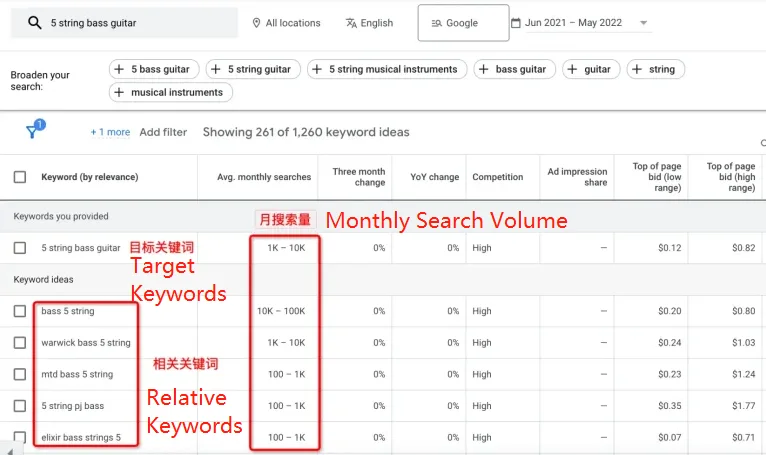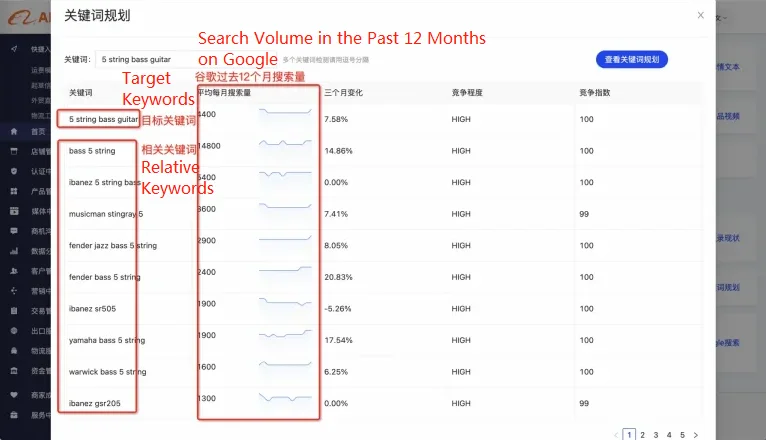Selecting keywords is not an untouched field to merchants, while finding a good and accurate keyword is always a head-scratching question. Here’re some suggestions to consider when choosing a keyword.
1. What is a keyword?
Keywords are chosen for a reason, and function as a “common language” between buyers and sellers. On the one hand, they lead the buyers to their target products and, on the other hand, they help sellers promote their products. They are also one of the most efficient ways to improve selling. All these benefits have made the selection a matter worth caution and consideration. So, what makes a keyword available? Here’re some must-have features:
- Certain search volume. This can be confirmed by using authorized search tools.
- High relativity to the product. Search pictures of the keywords to check if they’re directly related to the target product.
- Example: Some sellers may use “dry washer” when referring to their dry cleaning machine, but if you search the former’s related images in the search engine, you’ll see most results are not dry cleaning machine. In this case, a more accurate keyword is needed. What can not be neglected is that the results vary when searched at different server addresses. For example, if you search a keyword in North America and Europe, you’ll see two different result pages. Therefore, target clients’ addresses are also essential to consider when choosing the keywords.

2. How to select keywords?
Selecting keywords is to pick, among tons of results from acknowledged searching sources, the ones that are related tightly to your products and leave behind those that are not. This is a complicated process that requires patience and a full understanding of the products to complete.
2.1 Select keywords
Google Ads Keyword Planner, the official keyword tool, is recommended for keyword selection. If you don’t have an account with Google Ads, you can choose Alibaba’s Keyword Planner in its SEO Diagnostic Tool (in alpha). If you haven’t got permission to be an alpha user, click Keywords Widget and complete the selection.
- Example: Search “5 string bass guitar” with the official keywords tool, choose English in the language filter below, and All Locations in the region filter. Then you’ll see this keyword table.

2.2 Determine keywords
The relative keywords can be divided into various types, such as nickname keywords, manufacturer-related keywords, price-related keywords, feature-related keywords, topic-related keywords, brand keywords, etc. Click and download expanding more keywords.
- Example: On the result pages (like the following images), choose keywords that match “5 string bass guitar”, such as “five string bass guitar” (nickname keywords), “5 string bass guitar supplier” (manufacturer-related keywords), “5 string bass guitar for sale” or “5 string bass guitar price” (price-related keywords), “5 string electric bass guitar” (feature-related keywords). Then you can list them in a table.



2.3 Long-tail Keywords
Long-tail keywords, also known as long-tail words, refer to keywords that contain richer and more accurate information than target keywords. They have higher accuracy with a longer length, more content, and more specific information. Long-tail keywords are very important for attracting traffic, because they can bring precise traffic and are less competitive, which means that in optimization, long-tail keywords can easily stand out and bring traffic to product pages.
- Example: “educational books” is a general product term, while “educational books for autistic children” is a long-tail keyword.
Some relative keywords’ search volumes may not be high, but they can still lead traffic in and encourage inquiries, as long as they are specific enough. Except for manufacturer-related keywords which contain “supplier,” and price-related keywords, which contain “for sale” or “price,” that are mentioned above, there are more details:
- Manufacturer-related Keywords: Keywords containing “maker,” “supplier,” “factory,” “company,” “manufacturer,” or “distributor,” etc. For example, “dry washer maker” or “supplier of dry washer.” What needs to be clarified here is the product positioning. If your target is the Business, choose words like “factory” or “manufacturer.” While if your target is the Customer, choose words like “online.”
- Price-related Keywords: Keywords containing “price,” “for sale,” “wholesale,” “price list,” etc. For example, “dry washer price” or “wholesale dry washer.” What needs to be clarified here is the product positioning. If your products feature high-end quality, choose words like “high-quality” and “high-end.” If your products are economical, choose words like “cheap” and “affordable.”
- Nickname Keywords: In certain industries, products have many different names, except the common names. If these nicknames have been searched multiple times on the search engine, they can be used as keywords on product pages.
- Type-related Keywords: Keywords containing “kinds,” “types,” “categories,” “list,” etc. For example, “types of dry washers.”
- Feature-related Keywords: Keywords containing product features. Words like red, blue, and silver that describe the product’s color are within this range. For example, “silver dry washer.”
- Topic-related Keywords: Keywords containing interrogative words like “how,” “what,” “why,” “which,” “when,” etc. For example, “how does a washer dryer work.” Additionally, if the keywords include operating principles and production processes, they can also be considered topic keywords. For example, “the working principle of dry washer.”
3. How to insert keywords
After the selection completes, what should be tackled is the insertion. Inserting keywords in the copy on the product page is one of the most efficient ways to get more traffic. Keywords can be put everywhere in the copy, including the text, titles, and subtitles, as long as they are inserted rationally and don’t damage the copy’s coherence and originality.
- Coherence: The insertion must maintain the text’s basic consistency and readability. Never use keywords without limit for higher keyword density. Otherwise, the copy will receive punishment from the search engine.
- Originality: The copy must be original.
- Rationality: When keywords are embedded in the copy, they must conform to the semantic and grammatical rules.
- Example: The copy in Image 6 is an example of keyword insertion in the title and text. The core product keyword is “UPF clothing” with a monthly search volume between 1K and 10K. It is inserted in both the title and the text. Its nickname keywords like “Sun protective clothing” (10K~100K) and “UPF apparel” (10~100) are inserted in the text. All these insertions are beneficial in attracting buyers searching for the product with different keywords. Other than that, these insertion doesn’t break the text’s coherence, originality, and semantic and grammatical rules. Therefore, it can be confirmed that they are rationally inserted.